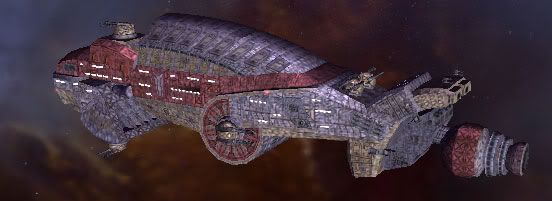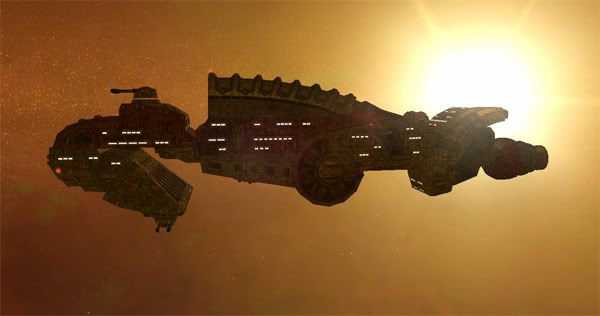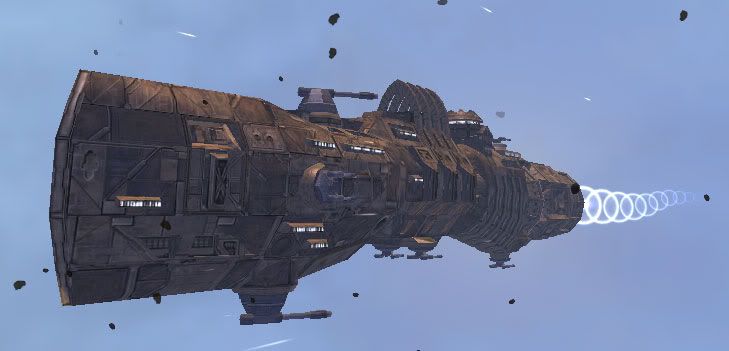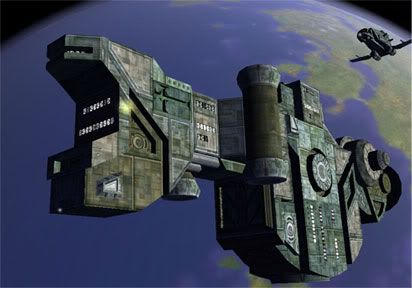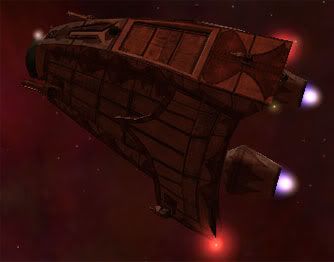
The Constitutional Monarchy of Bretonia
The Constitutional Monarchy of Bretonia, also known as the Bretonian Royal Empire or, less formally, simply Bretonia, is a large and economically powerful nationstate 23,000 lightyears from the Sol system. An industrial powerhouse, Bretonia is also home to several galaxy-renowned universities and research and development centres, and is commonly known for its high - if somewhat rigid - society. The nation has a rich and cultured history stretching back more than 800 years, though its exact origins are somewhat uncertain as records beyond that time are incomplete or unreadable. Bretonia's claimed territorial borders encompass several dozen star systems; eleven of which are under their direct jurisdiction, eight with permanent populations and three with large populations. Nine of these star systems are contained within the navigational anomaly known colloquially as the Great Barrier, through which access which is exclusively gained via Bretonia's private-owned Jump Gate network.
| Contents |
- People
- Society
- Criminal Organisations
- Economy
- Corporations
- Bretonian Space
- Cambridge System
- Dublin System
- Edinburgh System
- Leeds System
- Manchester System
- New London System
- Omicron Alpha System
- Omicron Beta System
- Omicron Gamma System
- Alpha-Epsilon System
- Beta-Epsilon System
- Bretonian Royal Armed Forces - General Data
- Bretonian Royal Navy
- Bretonian Royal Marines
- Bretonian Royal Army
- Bretonian Royal Precison Strike Forces
- Bretonian Small Arms
- Bretonian Royal Navy - Ship Data
- Bretonian Battleships
- Bretonian Warships
- Bretonian Support Craft
| People |
The Constitutional Monarchy of Bretonia supports an ever-growing population of 10.181 billion people, the bulk of which live on the heavily populated 'core worlds' of New London and Leeds. Bretonian law recognises no different castes or races amongst this population, with the only racial tag known to exist simply being 'Bretonian'. The population is entirely human, which for obvious reasons has led historians and biologists to assume that despite the lack of historical evidence, Bretonians are descended from Earth.
5.9 billion people live in somewhat cramped conditions on Planet New London, in the New London system. 3.056 billion people live on Planet Leeds, in the nearby Leeds system. There is a sociological rivalry between these two main population centres, with Leeds residents being thought of as rather grubby and uncivilised, and New London residents being thought of as snobby and spoiled, incapable of hard work. While neither generalisation is entirely accurate, it does lead to some hostility. Of the remaining population, most live on Planet Cambridge, with the rest choosing less habitable planets and space installations.
The average age of the Bretonian citizen is 35, with the average maximum lifespan being 93. This 'average' obviously varies between worlds however, and the fact that Leeds in particular has much lower averages than New London is a point of contention in society and political debates. The vast majority of people are between the ages of fifteen and sixty-five, with a slightly larger number of people being under fifteen than over sixty-five. With a birthrate of 18.28 per 1,000 people and a death rate of 11.24 per 1,000 people the population is climbing extremely rapidly.
In terms of gender ratios, males have a 0.1% advantage of numbers. Rarely is this a topic of discussion however - gender relations in Bretonia are highly equalised, with the only real distinctions being of a cultural nature rather than political or social. Indeed, at present a larger number of females are in employment than males, and on average they tend to earn more as well.
In terms of health, most known illnesses can be dealt with in private hospitals. A very small fraction of the population (under 0.0012%) suffer from an incurable terminal disease. Sexually transmitted diseases are the most prevalent form of major illness, despite the fact that all of them are curable with modern Bretonian medical science - most analysts put this down to embarrassment preventing people from receiving treatment. Genetic disorders are the second-largest form of major illness, with various genetic mental disorders taking the lead. However, a growing number of people are reporting health problems caused by extensive industrial pollution, a point which the money-centric government is keen to avoid dealing with in public.
Religion find support in a large minority of the Bretonian people, though it is a gradually dying force in modern society. Roughly 22% of the population follow any number of imported religions, the majority being some denomination of Christianity, and a significant minority subscribing to the Buddhist faith. 34% of the population describe themselves as agnostic, with no strong belief in any particular faith. The remainder describe themselves as strict atheists.
People from Bretonia are referred to as 'Bretonians' or 'Bretons'. The adjective is 'Bretonian'. Some sectors of the population prefer to use more localised terms, such as New Londonians for people from New London and Leedites for people from Leeds.
| Society |
Bretonian society is a complex one, spread across multiple star systems and between multiple classes. While there is some commonality, most notably in that all Bretonians speak Bretonian English, all Bretonians use the credit, and many forms of entertainment and literature transcend borders and backgrounds, it can nevertheless be difficult to quantify the 'culture' of the nation.
In terms of class divides, these are largely based upon financial status and familial standing. Upper classes, as a rule with exceptions, tend to live on Planet New London in one of the more opulent city-districts such as Trafalgar. They are characterised as being cold-hearted, tight-fisted but well-mannered and well-educated people, with a keen interest in higher arts such as opera and theatre, but having a largely unrealistic outlook on the world surrounding them. Nobility is often an important aspect of their life, and any upperclassmen with noble blood make a point to demonstrate that fact.
As a more vague genre, the middle classes can range from those who are financially successful, but not sufficiently so to enter into the exclusive realms of the aristocracy, to average families just scraping above an average household income. These are perhaps the most 'average' of Bretonians; they are either nine-to-five office workers or middle management, or perhaps moderately successful sole traders. Their entertainment tastes are as varied as their standard of living, and this particular class represents the highest proportion of holonet users.
Crushed beneath the boot of capitalist Bretonia, however, are the working classes. Typically employed in unskilled or manual labour, if employed at all, some may be scraping by well enough, while others are below the poverty belt. The stereotype suggests that they are all employed as miners by BMM, that they all live on Leeds, and that they all prefer to spend their time drinking in a bar or pub. While this isn't an accurate stereotype, at least one of those criteria can be applied to many of the less fortunate citizens of Bretonia. Although still somewhat conservative by the standards of many cultures, the working (or 'lower' as they are sometimes pejoratively referred to) classes are certainly less stiff-lipped than the snobs at the top of the food chain.
Popular forms of entertainment within Bretonia include mediums which are common to many societies, such as the Bretonian version of television, subspace radio, browsing the holonet, and attending sporting events such as football, hockey and starflier racing. Most average people do not attend live theatres particularly often, but the so-called 'higher arts' do flourish within Bretonian society, particularly on New London and Cambridge, where the majority of the educational elite tend to reside.
In terms of education, Bretonian children are required by law to attend school from the age of four until the age of sixteen, and public education facilities are widely available. Further education at colleges, technical colleges and university is available, though it is not provided for free - even so, large numbers of secondary school graduates do tend to take further education courses, taking out student loans to fund the expense. This trend has seen a subsequent rise in the number of people entering into technical professions upon leaving the educational system, and as such, has slightly increased the average wage.
This is virtually the only form of significant social welfare in the country, however. Healthcare is privatised, unemployment benefits are based on past National Insurance contributions, and the entire transportation network is also private.
Travel around Bretonia, for a civilian, is usually accomplished by the use of interplanetary tradelane rings, and interstellar jump gate systems, as civilian mobile FTL systems are expensive and often too cumbersome to fit onto smaller civilian ships. Besides which, it is also illegal for civilian ships which are equipped with FTL drives to engage these systems while inside the Great Barrier, due to concerns over safety - as such, it is legally required for citizens to utilise the tradelane and jump gate networks. These two networks, commercially owned and operated, form the backbone of internal transportation, whether travelling by personal starflier, mass transit ships, or freighters.
Tradelane rings, developed by Ageira Technologies, take the appearance of a 'figure of eight', and they are located near most planets and space stations of importance, creating a vast, criss-crossing network. Whenever a ship passes through a tradelane, it automatically deducts a fee from that licence holder's account, and then sends the ship off to the other end of the lane at the speed of light. While slow by interstellar standards, lightspeed is more than sufficient for interplanetary travel. Each 'ring' on the figure of eight is unidirectional and send ships in the opposite direction, effectively creating two-way traffic. The systems have proven to be extremely reliable, and have been a cornerstone of Bretonian society in the same way that modern roads are to us.
Jump gates, also developed by Ageira Technologies, allow for near-instantaneous travel from one star system to another. They are much larger than tradelanes, and more complex in their operations. Bretonian transpatial slipstream technology is somewhat unique and uncommon, though essentially it has the same effect as a wormhole. A jump gate is unidirectional, and another jump gate must exist on the other side in order for it to function - each jump gate is part of a matching pair, and cannot link up to any other gates. The 'floating doughnuts', as they have come to be known, have similarly found a firm place in Bretonian society, particularly since the construction of the Edinburgh <-> Alpha Epsilon Jump Gate.
| Criminal Organisations |
Though peaking and troughing over the years, crime is generally regarded as a problem within Bretonia. Organised crime in particular is of a size and scale not often seen in other nations, and may perhaps be partially attributed to the civilian tradelane and jump gate networks, which can be exploited for piratical purposes.
In addition to piracy, there are several organisations with political objectives foremost in their minds, and violent methods of putting their point across. These terrorists will often use piracy as a means of funding, or they will aid larger piracy syndicates in exchange for remuneration.
The four main criminal organisations operating in Bretonia are (amongst others):
Name: Corsairs
Organisational structure: 'Monarchy'
Leader: Unknown
Known activities: Piracy (with violence), smuggling, cybercrime
Equipment: Legionnaire Light Fighters, Centurion Medium Fighters, Titan Heavy Fighters, Marauder-class Capital Ships. Neutron weaponry confirmed
Size of membership: Between 5 - 10 million
Estimated annual income: Unknown; estimates vary between $10 billion to $100 billion
The Corsairs are by far the largest criminal organisation operating in Bretonian space; with millions of members and a hereditary 'monarch' of sorts, they function almost as a small, rogue nation. Despite their vast size, however, almost nothing is known about the internal workings of this 'micronation' - even the name, 'Corsairs', is a nickname attached to them in lieu of anything else to call them. From various hearsay and rumour it has been determined that they have a sort of hereditary monarchy at the head of their organisation, known as the 'Inner Sanctum', which consists of the 'monarch' and a council of advisors, but next to nothing is known about the workings of this clandestine government.
They are believed to be based within one of the three uninhabited star systems within the Bretonian Great Barrier; most of these systems hold environments which are ideally suited to camouflaging their operations, thanks to the presence of nebulae, dense asteroid fields, radiation and the like. It is within one of these systems they are thought to have a constructed their own shipyard facility, from which they are able to produce their various custom-designed fighters and even, more recently, ships approaching the size and capabilities of small capital ships. Most of these ships are well-armed and pose a significant challenge to military forces, indicating a skilled workforce and decent training regime.
The only thing known for sure is that the Corsairs have posed a significant threat to civilian traffic throughout Bretonian territory for over five centuries. Their swift, well-orchestrated attacks are usually limited to specific trade lanes, typically lanes which lie adjacent to environments that will allow them to retreat without being detected, such as asteroid fields and nebulae. They have even been known to mount attacks deep into Bretonian space against fortified ships and installations - even assaulting military battleships on occasions. Despite continued military vigilance and extensive information gathering operations, the Corsairs continue to plague trade and elude detection. Their highly organised, highly secretive society is very difficult to break into or quell with any significant success, while their own ability to hack into data-servers and even the Trade Lane network allows them to consistently choose their targets depending on the particular type of resources they require and to stay one step ahead of the police and military. They are also considered to be the largest supplier of illegal drugs in Bretonia, and they often use smaller criminal organisations - such as the New London Rogues and the Mollys - to distribute their wares.
Evidence has recently arisen to suggest that the Corsairs may have managed to smuggle some of their numbers and ships outside of the Great Barrier, presumably with the intention of expanding their criminal network into foreign territories.
As no Corsair warrior has ever been captured alive, partially due to their tendency to commit suicide when such an eventuality seems likely, much of what is known about them (outside of the obvious) comes from third-party sources or simple rumour.
Name: Mollys
Organisational structure: Terrorist cells united beneath a single banner
Leader: Patrick Kennedy (suspected)
Known activities: Terrorism, smuggling, piracy (with violence)
Equipment: Bloodhound light fighters, Wolfhound heavy fighters
Size of membership: Estimated to be 100,000 to 150,000
Estimated annual income: Unknown; piracy and gold smuggling are their primary sources of revenue, though these operations are limited
The Mollys are a terrorist organisation which originated in the Dublin star system, initially the result of an armed conflict which occured between BMM and several worker's unions which was waged over poor working conditions and low salaries. With the Dublin system filled with asteroids rich in gold, workers felt underpaid compared to the profits BMM was reaping from their hard work, and demanded pay increases. When their demands went unheeded, they solidified their unions and went on strike. Being a Royal Charter company, however, BMM was able to fire virtually all of the key members of the unions and hire new workers from the core worlds. In retaliation, the union representatives planted a bomb aboard one of BMM's key facilities in the system at the time. BMM immediately began stationing armed ships in the system, which started to engage union vessels in combat.
After the Bretonian Royal Navy began taking charge of security in the system, the unions merged to form the Mollys - their original goals long-since evaporated in favour of the much more lofty aim of gaining independence for Dublin from Bretonian rule. Establishing hidden bases deep within the vast asteroid fields of Dublin, they began launching terrorist attacks on any BMM property in the Dublin system, as well as the Bretonian people in general - their daring attacks have included placing nuclear devices within populated areas of New London. Their status has gradually risen from 'pesky annoyance in an isolated system' to 'serious threat' over the years, although recently their attacks have been less frequent and less severe.
It is known for a fact by the Bretonian government that the Mollys actively engage in piracy to fund their operations, and it is believed that they continue to mine gold from asteroids deeper in the Dublin field, for gold smuggling has become an issue. It is also thought that they cooperate to some degree with the Corsairs, who have been sighted using their bases as stop-off points, however any alliance between the two is almost certainly dominated by the vastly stronger Corsairs. Given that captured Molly members have consistently been unable to offer much information about the Corsairs, it appears that the Corsairs are tight-lipped even with their friends. It is known, however, that the Corsairs provide the Mollys with their Bloodhound and Wolfhound fighters; though inferior to Corsair ships, these fighters are sufficiently powerful to assault military fighter patrols and civilian convoys.
Their organisational structure is much easier to grasp than that of their elusive allies, however; each Molly facility operates as a 'cell', and only the leaders of each cell know the names and locations of the other leaders. At regular intervals these leaders will congregate to discuss the latest goals and status of their group as a whole. On multiple occasions the Bretonian military has learned of the locations and dates of these meetings, however the Mollys anticipate the Bretonian strike each time and fail to arrive - how they accomplish this feat of counter-intelligence is unknown, but most suspect that the Corsairs, once again, play a part in it.
What is most threatening about the Mollys, however, is that they command some degree of popular support. The Dublin Independence Party, an officially recognised political party with a handful of seats in the House of Commons, was originally founded by ex-Molly members, and debate continues amongst the populace as to whether their cry for independence is a reasonable one. Some Bretonian citizens are even accused of funding the organisation, particularly executives of the IMG, BMM's biggest competitor. The Bretonian government, however, has always refused to bow to the whims of terrorists, and continues a zero-tolerance approach - the Battleship Hood is permanently stationed in the Dublin system, with a specific mandate to hunt down and destroy any Molly ships or bases it can locate.
Name: Green Gaians
Organisational structure: Democratic
Leader: Gwyneth Jones (suspected)
Known activities: Terrorism, piracy
Equipment: Civilian starfliers and equipment only
Size of membership: 10,000 - 15,000
Estimated annual income: Unknown; thought to be quite low
The Green Gaians are a group of radical environmentalists with somewhat obsolete views. While they were originally formed to protest government intentions to colonise Planet Gaia in the Edinburgh system, plans which were cancelled anyway, they have since claimed to 'defend the natural world of all Bretonian planets'. They are particularly zealous about plans to restore the environments of New London and Leeds, though their ultimate wishes would involve returning these highly industrialised, densely populated planets to agrarian societies - wishes which are clearly infeasible.
Gaians are perhaps one of the least threatening criminal groups operating in Bretonia. They fly in conventional civilian ships, equipped only with civilian weaponry, and lack the organised structure of either the Corsairs or even the Mollys. While these ships are not threatening, they are difficult to identify, for unlike the ships utilised by the two largest criminal organisations in Bretonian, millions of these vessels exist in regular ownership. This can allow them to engage in some limited piracy against lone freighters, which they do only occasionally, presumably when they require more funding. Most of their activity is focused on the distribution of propaganda, however they will periodically commit acts of terrorism against industrial targets when they feel that their words are being ignored.
Where the Gaians are based is unknown, however. It is possible that they are not 'based' anywhere, and merely co-exist with the rest of the population until such a time as they are prepared to strike. It is known that they function democratically, with members choosing their own leaders, and even holding referendums over major decisions to be made by the group. Due to their decentralised and 'ordinary' nature it has proven difficult to track them down, though as they are not as sophisticated (nor as determined) as some other criminal organisations, the Bretonian government does have a much higher arrest rate amongst this much smaller group.
Name: New London Rogues
Organisational structure: Somewhat oligarchical
Leader: Unknown
Known activities: Piracy (with violence), smuggling
Equipment: Various stolen ships, even including Molly Bloodhounds and Wolfhounds
Size of membership: Roughly 20,000
Estimated annual income: Roughly $30 million
The New London Rogues are the result of the biased, class-based society of the New London system, though a large proportion of their number are also from Leeds. Unemployed, usually convicted of petty crimes, and generally down-trodden by the rest of society, the Rogues take heed of the phrase "honest work is hard". Why work fifty hours a week to buy a loaf of bread when they can just steal the bread?
Rogues are well-known to the Bretonia Police Authority, with a large proportion of their numbers generally being repeat offenders and well-known faces in prisons. Almost as soon as they are released from prison, they tend to head straight back into the arms of their gang and recommence their criminal activities, before being caught and sent back to prison. They are the ultimate class of thugs, thieves and good-for-nothing, work-shy crooks - but their organisation is like a family to them, and they care for each other as though they were blood.
Primarily these days the Rogues act as pawns for the Corsairs, selling their drugs throughout Bretonia in exchange for a share of the profits. As with the Mollys, captured Rogues have never been able to yield any useful information about the Corsairs, and given that almost all of their ships are stolen, it is reasonable to assume that the Corsairs do not regard them as highly as they do the Mollys, for they do not provide them with equipment. When not pushing drugs into the various population centres of Bretonia, the Rogues engage in piracy of their own - however, they lack the finesse of the experienced, well-trained and well-equipped Corsairs, typically engaging in a brute-force assault, often destroying the very cargo they intended to steal and frequently being arrested afterwards. Despite their overall incompetence, their numbers and casual disregard for human life have seen them rise in fame over the years.



